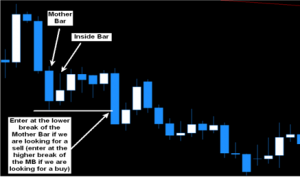Inside Bar Candle Formation Strategy
Introduction to Inside Bar Strategy – Revised by Bogdan G.
The Inside Bar strategy is a binary options trading strategy that uses the inside bar candle formation on any candlestick or bar chart to determine when an asset is due for a reversal movement. If the Inside Bar occurs at overbought levels, it is a possible sell signal, and if it occurs at oversold levels, this is an indication to buy the asset. The Inside Bar candle formation is a 2-candle formation in which the 2nd candle has a lower high and a higher low than the 1st candle. In essence, the 2nd candle is enveloped inside the 1st candle. The first candle is called Mother Bar and the second one is the Inside Bar. The strategy works best on the higher time frames, but it can be used successfully on the lower ones as well, even if more false signals are likely to appear.
To generate a trade signal, the trader does the following:
Overbought conditions looking for a sell signal: He draws a horizontal line from the Mother Bar’s low and then waits for a candle to close below the line. This can happen after several candles because it is not uncommon to see more than one Inside Bar after the Mother Bar. The entry is taken immediately after the close of the candle that broke the low of the Mother Bar, only if the close of that candle is below the line.
Oversold conditions looking for a buy signal: He draws a horizontal line from the Mother Bar’s high and then waits for a candle to close above this line. This can happen after several candles because it is not uncommon to see more than one Inside Bar after the Mother Bar. The entry is taken immediately after the close of the candle that broke the high of the Mother Bar, only if the close of that candle is above the line.
Why does the InsideBar Strategy Suck? My Opinion
The signal application is kind of confusing, and it is almost a sure thing that beginners will mix up the signals and make an entry based on a fakeout. Patience is the watchword for this strategy, and unfortunately, a trader who is too patient will miss the entry and enter into the trade late. Frankly, this strategy should only be used by those with some degree of experience in the financial markets.
Why the InsideBar Strategy May Not Suck After All
The Inside Bar strategy can be modified to include the use of oscillators that indicate overbought and oversold conditions in the market. The Stochastics oscillator is one such indicator and can help filter the fakeouts produced by the inside bar.
Conclusion
The Inside Bar strategy is a tricky system to deploy. It is very easy to generate a false signal with this strategy. Traders who do not have much experience with the Inside Bar strategy will not factor in any pullbacks in the entry candlestick and so may set wrong price barriers in the binary options trades. However, this can be overcome if the trader makes allowance for any pullbacks in the entry candle (which does not usually extend to the halfway point on the preceding candle), and if the trader sets a minimum expiry of one hour.
